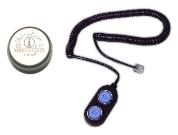Home fridge temperatures
Ever wondered what’s happening inside your home fridge when the door is closed and that little light is off? Just how cold is your refrigerator? How well is it keeping your household safe from foodborne illness bugs?
What happens during parties and special events?
The Food Authority’s scientists wondered just that. Here’s how they explored the temperature safety of domestic fridges and what they found.
Study outline
Throughout 2009, the Food Authority's scientists used automatic data loggers to monitor the temperature inside a series of home fridges in NSW. They were looking at the how fridges work when left alone, and the effect on the temperature inside from typical activities over the course of a weekend.
The optimum temperature for home fridges is between 0oC and 5oC.
 Temperature data loggers
Temperature data loggers
These are devices which record temperatures at regular intervals. The recordings can later be downloaded onto a computer for analysis.
The Food Authority's field staff use the loggers to record the temperature of food sample containers when transporting them from food outlets to laboratories for testing.
Using the logging device helps to verify that any bacteria in a food sample did not have a chance to grow after the sample was taken because they were warm when transported. They also help establish a reliable evidence trail.
Maintaining the optimum temperature inside a fridge is important to minimise the growth of bacteria that can cause food poisoning and spoilage:
- too warm and food poisoning bugs can start to grow
- too cold and foods can freeze, which will damage some foods.
Temperature loggers (see inset) recorded the internal air temperature for 57 home fridges every 10 minutes for two days. The logger was hung underneath the middle shelf. Another 8 fridges were studied over special event periods such as Easter and New Year’s Eve celebrations.
Each household was asked to log major 'fridge events' when the fridge door was opened such as preparing a meal, putting shopping away, catering for visitors and so on.
Information was also collected on the age of the fridge, its capacity, the type of internal shelves (solid or wireframe, which affects air circulation), the number of people in the household, the participant’s own rating of the condition of the seals, and so on.
Some good news
The results show that most fridges stayed mostly within safe temperatures. 77% of fridges had an average temperature - both mean and median, of 5oC or below.
Many fridges were good at maintaining temperature and quickly returned to safe temperatures after the door was opened.
Air temperatures inside the fridges might go above the ideal for short periods after the door is opened without causing any safety problem, of course. Fortunately, 82% of the fridges had no period when the inside temperature was above 5oC for more than two hours. Two hours at above 5oC might have allowed food to start warming up and bacteria to grow.
Some bad news
Fridge temperature profiles can vary a lot:
-
some fridges had to work very hard to maintain proper temperatures
-
others had big temperature spikes and took a long time to return to the right temperature, or were never cold enough. These represent the greatest food safety risk if the temperature of the food also rises above 5°C.
23% of the fridges had an average temperature - either a mean or a median - above the safe level of 5oC, although for many it was still very close to the threshold. But 9% had an average above 6oC. Food in these fridges might become warm enough for long enough to allow harmful bacteria to grow.
18% of the fridges had at least one period where the temperature stayed above recommended levels for 2 hours or more. Of special concern: 4% (2 fridges) stayed above proper temperatures for the whole time they were monitored.
Everyone was given a print out of the results for their fridge and some participants - including these last 2 - were given recommendations on how to improve the safety of their fridge.
Regular activities
Certain activities stood out as having a major impact on fridge temperatures:
Meals
In some households - but not all of them - preparing the evening meal can be associated with a very rapid rise in temperature from which it takes many hours to recover.
- Lesson: when preparing meals don’t open the fridge door too often or leave it open
In our example fridge below, the temperature hasn’t even recovered before dinner is finished and the leftovers are packed away. This was a medium age (10-year-old) fridge, with 'poor' seals and solid shelves (less air flow). When left alone it maintained a good temperature.
During meal preparation, was the door left open for long periods? We don’t know. But the problem was compounded by this being a very poorly performing fridge which never got down to the recommended temperature. It only reached its lowest temperature by breakfast time the next morning!

Figure 1: Dinner preparation can raise the temperature and take hours to recover from.
Cleaning & shopping
Cleaning a fridge, which would mean the door was open for a long time, can also see the inside temperature rise to unsafe levels for long periods.
- Lesson: give the fridge time to recover its air temperature after cleaning.
Loading the fridge with shopping is also shown on the figure below.
Because the food was warmer than inside the fridge and has some bulk, it took the fridge as much as 6 hours to recover to a safe temperature.
- Lesson: when shopping buy your cold food last, transport it in a cooler bag and get it home and into the fridge quickly so it's as cold as possible when it goes into fridge
- Lesson: after loading the shopping, keep the door closed for several hours to give the fridge time to recover its temperature.

Figure 2: Cleaning and loading the shopping can raise the temperature and take many hours to recover from.
Events & parties
Loading the fridge, especially with a lot of drinks for a party, can have a huge effect on the fridge temperature for the rest of the day.
In our study, a small number of fridges were monitored over ‘special event’ weekends, such as Easter and New Year’s Eve.
In our example below, drinks were loaded at lunchtime on News Year’s Eve into a medium age, medium sized fridge with wireframe shelves and seals rated as ‘good’. It took the whole of the afternoon to get its air temperature back to 5oC. The air - and presumably the drinks - got to a refreshing 2oC just in time for the party at 7.30 pm. But the food inside had been exposed to warm air for up to 4 hours, which is starting to get very risky. And the temperature started to bounce around as party guests topped up their drinks. Notice the spike just before midnight! Foodborne illness bacteria love warmth.
-
Lesson: cool drinks for parties and special events in an esky or bath tub filled with ice or a separate fridge.

Figure 3: filling a fridge with drinks for a party can raise the temperature for the rest of the afternoon
Keep it cold!
Some activities including meal times, putting groceries away and parties can cause some fridges' temperature to stay above safe levels for long period so:
- close the door quickly each time removing or placing food in the fridge
- avoid overloading a fridge, especially when catering as this reduces air flow inside and the fridge has to work much harder to keep the correct temperature
- check the fridge temperature is at 5°C or below. Fridge thermometers can be bought from fridge retailers, kitchenware stores and hardware stores for as little as $10
- have a well insulated, efficient fridge with door seals in good condition.
For other simple tips on keeping food cold and low risk see:

